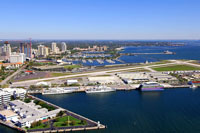Overview
 Numerous federal agencies operate watercraft from various ports and harbors throughout the United States. These include the U.S. Navy, U.S. Coast Guard, NOAA. Fish and Wildlife Service, and the U.S. Army Corps of Engineers. Vessel types include warships, search and rescue vessels, research watercrafts, dredges, and dormitory boats.
Numerous federal agencies operate watercraft from various ports and harbors throughout the United States. These include the U.S. Navy, U.S. Coast Guard, NOAA. Fish and Wildlife Service, and the U.S. Army Corps of Engineers. Vessel types include warships, search and rescue vessels, research watercrafts, dredges, and dormitory boats.
Typically the home ports for these watercraft have a variety of activities and facilities which impact the environment. This portion of the Facility Regulatory Tour addresses those shore activities and limited activities which take place in the water. It does not address environmental issues on the watercraft themselves.
Focus Areas
 Dredging
Dredging
The removal of materials such as sand, silt, and clays in an existing navigation channel. Maintenance dredging is performed periodically to remove bottom sediment that has been naturally deposited through time.
 Fuel Storage and Dispensing
Fuel Storage and Dispensing
Fueling of vessels, trucks, and other equipment (i.e., onshore steam generators) along with the storage of fuel in aboveground or underground storage tanks. Fuel includes: diesel, kerosene, gasoline, and biofuels.
 Shore-based Support Operations
Shore-based Support Operations
This includes facilities and activities such as: recycling; solid waste collection; recycling; restrooms; offices; vehicle maintenance; heating, ventilation, and air conditioning repair; plumbing operations and services; pesticide applications; building repair and maintenance; and janitorial services. It also includes watercraft maintenance and repair. Heavy equipment often founds in ports and harbors to facilitate maintenance and repair includes gantry cranes, conventional cranes, fork lifts, trucks, buckets & grapples, bull dozers pay loaders, boom trucks, welding trucks, water trucks, excavators, sweepers, pumps, tug boats, deck barges, hopper barges, crane barges, trackers, flat beds, fuel oil tankers, bulk cement trailers, engines, etc.
 Spill Response
Spill Response
Depending on the volume of fuel stored onsite, location, and activities occurring certain non-transportation-related onshore or offshore facilities that store, transport, or dispense petroleum products are required to prepare either a Spill Prevention, Control, and Countermeasure (SPCC) Plan or a Facility Response Plan (FRP). They are also required to adequately train their personnel in spill response procedures.
 Watercraft Wastewater Discharges
Watercraft Wastewater Discharges
Two types of watercraft-unique wastewater are ballast water and bilge. Vessel wastewater discharges are primarily regulated by EPA's NPDES Vessel General Permit (VGP).Bilge is the lowest compartment of a ship where the two sides meet and where water collects from rough seas, rain, minor leaks in the hull. Bilge is where oil, solvents, detergents, chemicals, urine, and other wastes that have accumulated while out at sea. Ballast water is taken onboard for stability prior to a voyage and then released into the water once the destination is released.
(NOTE: For additional information on ports and harbors consult PortCompliance.org. This port sector tool was developed in partnership between the National Center for Manufacturing Sciences (NCMS) and Environmental Protection Agency (EPA) Region 2 with the support and assistance from the Port Compliance Assistance Focus Group consisting of industry, federal, and state regulatory agencies.)



